Understanding Brilliant Shape Diamonds: Characteristics & Trends
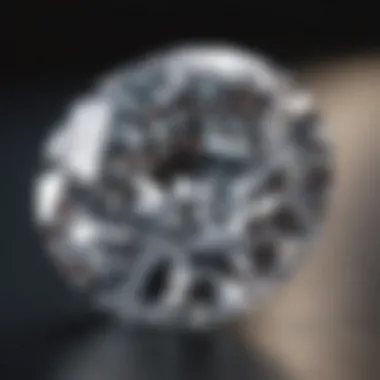
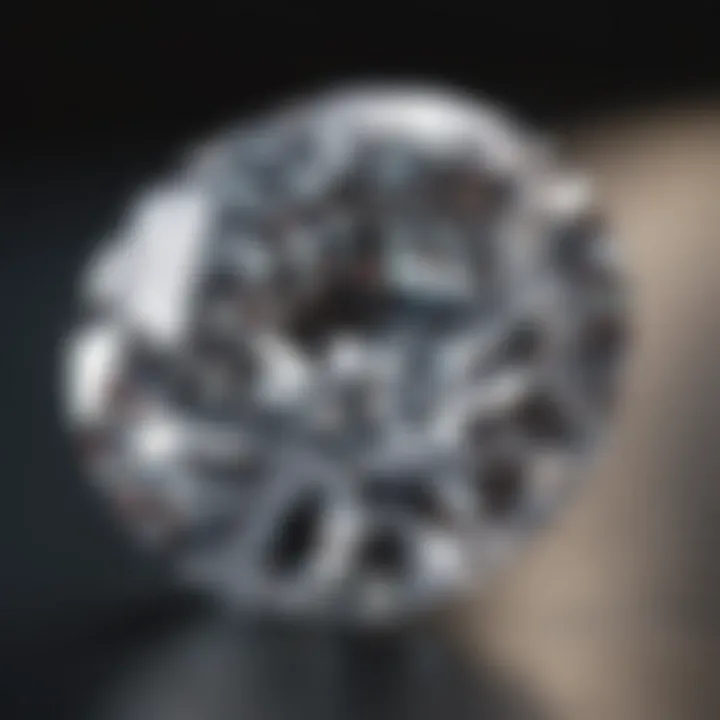
Intro
Brilliant shape diamonds are not just visually stunning; they embody a rich tapestry of history, artistry, and value. Understanding these precious stones goes beyond mere aesthetics—it includes their unique qualities, cutting methods, and significance across various cultures. In this exploration, we will dissect the complexities of brilliant shape diamonds, providing insight for both enthusiasts and professionals.
Gemstone Overview
Definition and Characteristics
Brilliant shape diamonds, known for their intricate cuts and superior light reflection, are a subset of diamonds designed to maximize brilliance and fire. A key characteristic of these diamonds is their specific shape of 57 or 58 facets, enabling exceptional sparkle. The most common brilliant shape is the round cut, which accounts for a significant part of the diamond market. Other popular shapes include the princess, oval, and emerald cuts, each offering different appeals. The quality of a diamond is assessed through the Four Cs: Carat weight, Cut, Color, and Clarity. Each of these factors plays a crucial role in determining the stone's value and desirability.
Classification of Gemstones
Gemstones can be broadly classified into precious and semi-precious stones. Diamonds are categorically placed in the precious category, primarily because of their rarity and desirability. Within the diamond classification, gems can be further divided based on their cut, clarity, color, and origin. This classification structure is pivotal for buyers and collectors, as it helps them determine the potential value and significance of each piece.
Historical Significance
Ancient Uses and Cultural Importance
Historically, diamonds have been used for various purposes, ranging from tools in ancient India to symbols of power and status in modern times. In ancient cultures, diamonds were believed to possess protective properties, warding off evil and ensuring victory in battle. They were often associated with royal lineages, used in crowns and ceremonial artifacts to signify wealth and power. In India, diamonds were cherished for their inherent beauty and mystical attributes.
Myths and Legends Surrounding Gemstones
The allure of diamonds is wrapped in numerous myths and legends. Many cultures attributed unique powers to these stones. For instance, some believed that diamonds could cure illnesses, while others saw them as talismans that could bring love and luck. These narratives have been passed down through generations, solidifying the diamond’s place in human history.
"Diamonds are a symbol of eternity; they mark significant life events and are often given as tokens of love and commitment."
Ending
Preamble to Brilliant Shape Diamonds
The world of gemstones is rich and diverse, but brilliant shape diamonds hold a particularly brilliant status. These gems are not just beautiful; they are finely crafted works of art that blend nature's wonders with human skill. Understanding brilliant shape diamonds is essential for gemstone enthusiasts, collectors, and anyone interested in jewelry design. This section will explore the numerous factors that make these diamonds so special.
Brilliant shape diamonds are recognized for their intricate cuts, which maximize their brilliance and fire. The technical specifications of these cuts play a crucial role in how light interacts with the diamond. This interaction enhances their overall visual appeal. For collectors, knowing how to identify these qualities is key to appreciating a diamond's value.
Moreover, purchasing a brilliant shape diamond represents a significant investment, both financially and emotionally. This makes it vital for buyers to comprehend not just the beauty of the stone but also its underlying characteristics and market trends. With a variety of cuts available, navigating the buying process can be daunting. Thus, acquiring knowledge about brilliant shape diamonds is essential.
Understanding the Term ‘Brilliant Shape’
The term 'brilliant shape' refers primarily to how diamonds are cut. A brilliant cut is characterized by its precise facets that create an exceptional reflection of light. This cut allows diamonds to possess extraordinary shine, especially in well-lit environments. The shape signifies a balance between artistry and mathematics, where each angle and facet must be thoughtfully calibrated.
In practical terms, the most noteworthy type of brilliant diamond is the round brilliant cut, which is perhaps the most popular choice among consumers. Other variations, like the princess cut or oval cut, also fall under this category. Each possesses its own qualities yet shares the fundamental brilliant cutting principles.
Key Points of Understanding Brilliant Shape Diamonds:
- Definition and Significance: Grasp the meaning behind the term 'brilliant shape.'
- Importance of Cut: Recognize the role that cutting plays in a diamond's appeal.
- Market Perspective: Acknowledge the consumer demand for these specific cuts in both retail and investment settings.
Historical Overview
The significance of understanding the historical background of brilliant shape diamonds cannot be overstated. This section connects readers with the evolution of diamond cutting and how it shaped the current market and aesthetic perceptions. The story of diamond cutting is not just about craftsmanship; it involves cultural shifts, technological advancements, and economic factors that influenced how these stones are viewed and valued today. Moreover, this historical context provides insight into the reasons behind the popularity of certain cuts, including the brilliant cut, among consumers and collectors. By exploring the origins and development of diamond cutting techniques, readers can better appreciate the artistry and precision involved in creating these exquisite gemstones.
The Origin of Diamond Cutting Techniques
Diamond cutting techniques began to take form during the late Middle Ages. The earliest diamonds were not cut but worn in their natural octahedral shape. This was primarily because cutting tools were rudimentary, and the technology to cut and shape diamonds effectively did not exist. The first attempts at diamond cutting can be traced back to the 13th century in Europe, where gem cutters began to apply various methods to enhance the natural beauty of diamonds.
The art of diamond cutting first blossomed in Venice and Bruges. Craftsmanship was rudimentary, but these early methods laid the groundwork for more complex techniques. It was not until the introduction of the rose cut in the 16th century that significant advancements emerged. This cut, featuring a flat back and a domed top with triangular facets, began to maximize the reflection and refraction of light, enhancing the stone's visual appeal.
A major breakthrough occurred in the late 19th century with the invention of the brilliant cut by Marcel Tolkowsky. His meticulous geometry and keen understanding of optics led to the creation of the round brilliant diamond cut. This cut is defined by 58 precise facets, allowing light to reflect and return to the viewer's eye in a captivating manner. As a result, Tolkowsky's brilliant cut became the gold standard in the industry, and it remains the most popular diamond cut today.
Evolution of the Brilliant Cut
The evolution of the brilliant cut illustrates the intersection of art and science. Tolkowsky's principles were often discussed in workshops and academic circles, slowly spreading across the diamond industry. By the early 20th century, mastering the brilliant cut became an essential skill for diamond cutters.
During this time, several factors contributed to its rise:
- Technological advancements: Improved cutting tools allowed for more intricate designs and a higher degree of precision.
- Market demand: The desire for more brilliant stones surged, influencing production methods and marketing strategies.
- Cultural shifts: The rise of engagement rings in Western cultures led to a greater appreciation for diamond cuts, especially the brilliant cut.
The mid to late 20th century saw further refinement of cutting techniques. Jewelers began to experiment with shapes while still adhering to the principles established by Tolkowsky. Many new cuts, influenced by the brilliant cut's mathematical foundation, emerged. This not only diversified the market but deepened the appreciation for diamond artistry. As a result, the brilliant cut remained at the forefront, proving its timeless allure.
The historical narrative of brilliant shape diamonds embodies a blend of artistry and scientific finesse. Acknowledging these historical milestones enhances appreciation among jewelers, collectors, and enthusiasts alike, fostering a deeper connection to the stones they admire.
Technical Specifications
Understanding the technical specifications of brilliant shape diamonds is essential for both appreciation and investment purposes. These specifications relate to how the diamond is cut, its dimensions, and the optical phenomena it presents, such as brilliance and fire. Each element contributes to the overall charm and market value of a diamond. Familiarity with these specifications allows buyers and enthusiasts to make informed decisions when acquiring these gems, ensuring they understand what they are valuing.
The Anatomy of Brilliant Shape Diamonds
The anatomy of a brilliant shape diamond encompasses its critical components: the table, crown, girdle, pavilion, and culet.
- Table: This is the flat surface on top of the diamond, and its size directly influences the diamond's overall appearance.
- Crown: The upper portion above the girdle, which contributes to the diamond's overall silhouette and sparkle.
- Girdle: This is the widest part of the diamond, serving as the boundary between the upper and lower parts. A well-proportioned girdle allows for better light performance.
- Pavilion: The lower portion of the diamond, which reflects light and enhances the gem's brilliance.
- Culet: A small facet at the bottom, or point, of the pavilion that should ideally be pointed to prevent light leakage.
These elements are not just for aesthetics; they influence how light interacts with the diamond, affecting its brilliance and fire. Each component must be carefully cut and proportioned to together create a diamond that captivates and dazzles.
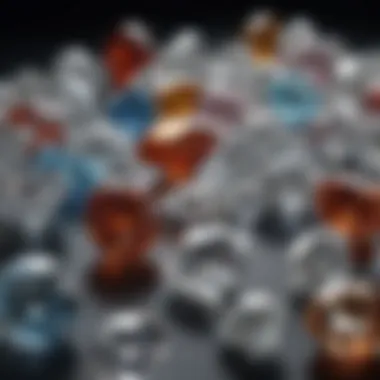
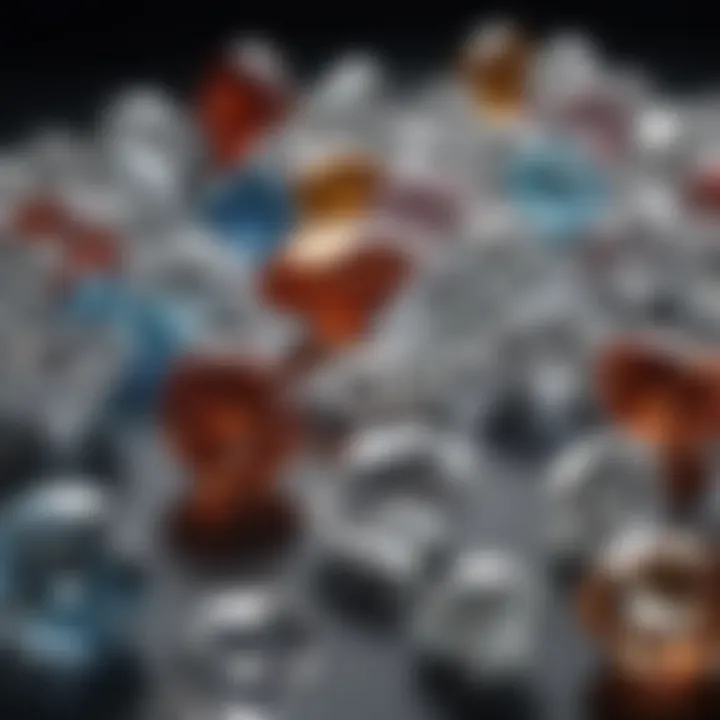
Celebrities of the Diamond World
In the world of diamonds, certain stones have gained notoriety due to their size, historical significance, or unique characteristics. Among these, the Hope Diamond stands out as one of the most famous. Its deep blue color and storied history attract both gem enthusiasts and casual observers alike.
Another notable diamond is the Cullinan, which was cut into several significant gems, including the Great Star of Africa. This diamond is known for its incredible size and clarity, symbolizing luxury and opulence.
Collectors and enthusiasts often find themselves fascinated by these remarkable pieces, not only for their beauty but also for the stories behind them. Investing in such celebrities of the diamond world can bring a deeper appreciation for the craft of diamond cutting and the cultural importance these stones hold.
Understanding the stories of these diamonds helps individuals appreciate brilliant shape diamonds in a broader context of history and value.
Classification of Diamonds
The classification of diamonds is a pivotal part of understanding their appeal and functionality within the gemstone market. By recognizing the diverse cuts and styles available, consumers and collectors can make educated decisions regarding their investments. Classification not only enhances knowledge about diamonds but also helps in identifying a diamond’s unique characteristics and value. Each classification delineates not only the physical aspects but also the aesthetic qualities that diamond buyers may consider.
Various classifications exist, with the most notable being shape, cut, clarity, color, and carat weight. Collectively referred to as the "Four Cs", these factors serve as a foundation in the evaluation of diamond quality. Understanding these classifications is vital because they determine a diamond's marketability and worth.
Different Cuts: An Overview
When discussing the classification of diamonds, one cannot overlook the significance of the various cuts. Each cut not only affects the diamond's appearance but also contributes to its ability to reflect light. Among the many cuts available, the most popular ones include the round brilliant cut, princess cut, cushion cut, and emerald cut.
- Round Brilliant Cut: This is perhaps the most recognized diamond cut, featuring a circular shape with 58 facets. It is celebrated for its capacity to maximize brilliance and fire, making it a favored choice for engagement rings.
- Princess Cut: This cut has a square or rectangular shape with pointed corners. The design allows for a high level of sparkle and is often chosen for its modern aesthetic.
- Cushion Cut: Combining square cut with rounded corners, the cushion cut is known for its romantic appearance. It tends to exhibit a softer sparkle compared to other cuts, often appealing to those who prefer a vintage style.
- Emerald Cut: With its rectangular shape and step-cut facets, the emerald cut emphasizes the clarity of the diamond rather than its brilliance. This cut has gained popularity for those seeking a more sophisticated look.
The cut of a diamond also affects its light performance. The interaction of light with the diamond can create various visual effects that appeal to different tastes. Additionally, knowing the strengths and weaknesses of each cut helps consumers select a diamond that aligns with their preferences.
"The cut of a diamond is its most crucial characteristic, influencing beauty and sparkle."
Characteristics of Brilliant Diamonds
Brilliant shape diamonds present a captivating combination of distinct characteristics. These elements define the stones and contribute to their desirability among collectors and enthusiasts. Understanding the characteristics of brilliant diamonds is crucial for appreciating their aesthetic value, investment potential, and unique appeal.
Brilliance and Fire Explained
The terms "brilliance" and "fire" are often used when discussing diamonds, particularly brilliant shape diamonds. Brilliance refers to the white light that a diamond reflects. It is influenced primarily by the quality of the cut and how well the facets interact with incoming light. The cut of a diamond determines its proportions, symmetry, and how well it captures and reflects light. A well-cut brilliant diamond will exhibit a high degree of brilliance, which makes it more visually appealing.
Fire, conversely, describes the dispersion of light into its spectral colors. When light enters a diamond, some of it breaks down into different colors, creating a rainbow effect. The better the cut and clarity, the greater the fire a diamond will exhibit. Both brilliance and fire work together to enhance the overall beauty of a diamond, making these characteristics vital considerations when evaluating a stone.
Clarity and Color: What to Look For
Clarity and color are equally significant when assessing the characteristics of brilliant shape diamonds. Clarity indicates the presence of internal or external flaws, known as inclusions and blemishes. Diamonds with higher clarity typically command higher prices due to their rarity. The clarity scale ranges from Flawless (no inclusions visible under 10x magnification) to Included (inclusions visible to the naked eye).
Color is another essential factor in evaluating diamonds. The diamond color scale ranges from D (colorless) to Z (light yellow or brown). Colorless diamonds are the most sought after because they allow the most light to enter and reflect, enhancing brilliance and fire. When selecting a diamond, look for a color grade that appeals to your aesthetic but also consider how it complements the stone’s clarity and overall quality.
"Understanding the interplay of brilliance, fire, clarity, and color enriches your experience in the world of diamonds, making you a more informed collector or buyer."
In summary, recognizing these specific characteristics of brilliant diamonds can inform your purchase decisions and appreciation for their beauty. Each diamond's brilliance, fire, clarity, and color contribute meaningfully to its overall presentation. As a result, a nuanced understanding can lead to better investments and more fulfilling ownership experiences.
Cutting Techniques
Cutting techniques are vital in determining the aesthetic appeal and overall quality of brilliant shape diamonds. The process maintains significant influence over how light interacts with the stone. Therefore, a well-executed cut amplifies the stone's brilliance, fire, and scintillation, making it more desirable. Moreover, different cuts can affect how the diamond appears in various lights, emphasizing its allure.
The Precision of the Brilliant Cut
The brilliant cut is arguably the most recognized and sought after diamond cut. Its design mainly features 57 facets, expertly arranged to maximize light reflection. This arrangement ensures that the diamond appears vibrant and lively. The precision involved in producing a brilliant cut is meticulous. It requires specific angles and proportions that deliver exceptional brilliance.
An important element of the brilliant cut is its table size. The table is the flat top surface, where light enters the diamond. If it is too large or too small, it can reduce the diamond's ability to reflect light. Therefore, cutters must maintain rigorous standards during the shaping process. Additionally, a high level of craftsmanship is necessary to balance the proportions effectively. Even slight errors can lead to a considerable decrease in quality.
Technological Advances in Diamond Cutting
Recent years have seen notable advancements in diamond cutting technology. These improvements have transformed how diamonds are cut and processed, enhancing the precision of the cuts. Computer-aided design (CAD) software now plays a crucial role, allowing diamond cutters to visualize and plan cuts more efficiently.
With the introduction of laser cutting techniques, the accuracy in achieving the perfect cuts is significantly higher. This technology allows for intricate designs that were previously impossible or required excessive manual labor. Laser technology not only enhances precision but also reduces wasted material, making the process more economically viable.
These advancements lead to more consistent results across the diamond industry. As a result, the quality of brilliant shape diamonds has improved, setting a new standard for the market.
Metaphysical Properties
The metaphysical properties of brilliant shape diamonds have long captivated both enthusiasts and professionals within the gemstone community. These properties are often intertwined with both historical beliefs and modern interpretations, providing a rich tapestry of understanding that enhances the appreciation of these exquisite stones. This aspect of diamonds is not merely ornamental; it represents a deeper significance that can influence how individuals choose to connect with and value their stones.
Historical Beliefs and Practices
Throughout history, diamonds have been attributed with a myriad of metaphysical properties. In many ancient cultures, these gemstones were perceived as symbols of power, purity, and protection. Ancient Romans believed that diamonds were splinters from fallen stars, thereby associating them with celestial strength. In India, diamonds were considered to hold the energy of the cosmos, often used in rituals and decorations of deities.
Diamonds have also been regarded as talismans to ward off negative energies. Kings and emperors adorned themselves with diamond jewelry, believing it brought them invincibility and safeguarded against enemies. In many traditions, the possession of a diamond was seen as a pathway to enlightenment, fostering both spiritual growth and inner peace.
Modern Interpretations
In contemporary discussions about the metaphysical significance of brilliant shape diamonds, the focus shifts towards personal interpretation and emotional resonance. Many individuals now view these gemstones not only as symbols of wealth but as carriers of energy that can influence one's life positively. For instance, diamonds are often associated with love, strengthening relationships, and enhancing fidelity. Furthermore, practitioners of crystal healing suggest that diamonds can amplify intentions and manifestations, making them ideal for setting goals or personal transformations.
There is an increasing interest among gemstone enthusiasts in how these stones can enhance meditation practices. The clarity and brilliance of diamonds are thought to aid in achieving higher states of consciousness.
The modern perception of brilliant shape diamonds as metaphysical tools reflects a delicate balance between ancient beliefs and current interpretations. This duality enriches the understanding of diamonds, inviting new generations to explore their significance far beyond mere aesthetic appeal.
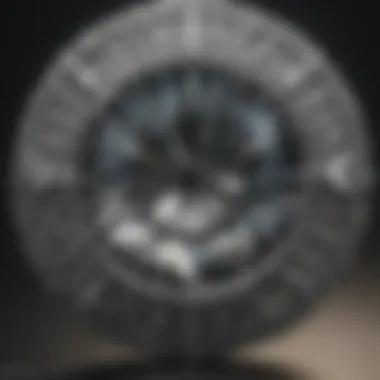
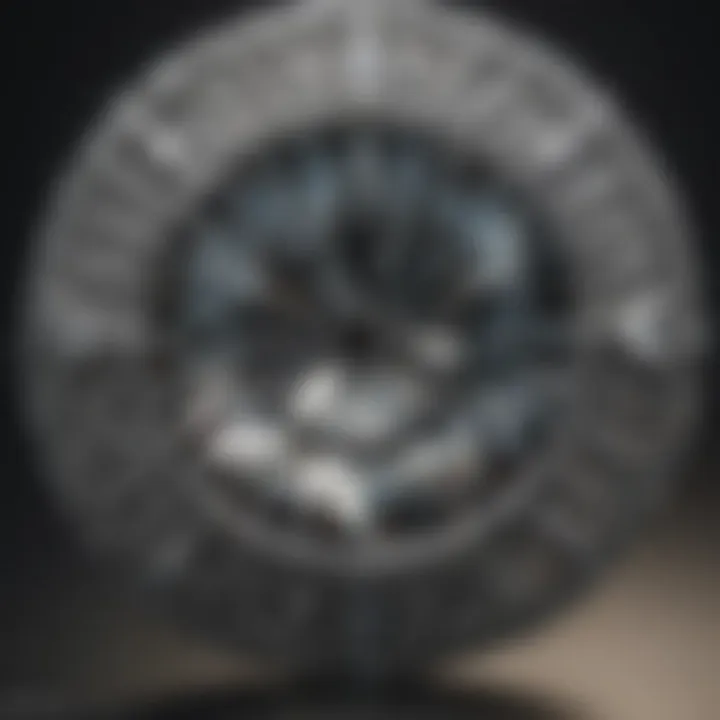
"The belief in the inherent power of diamonds persists, and contemporary practices adapt these views to modern needs, reflecting an ever-evolving relationship with these precious stones."
In summary, the metaphysical properties of brilliant shape diamonds highlight their multifaceted roles in human culture, bridging the past with present needs and desires. This layer of significance adds depth to the already rich narrative surrounding these remarkable gemstones.
Investment Value
The investment value of brilliant shape diamonds is a topic that merits significant attention. Investors often seek tangible assets that hold or appreciate in value over time. Diamonds, particularly those with a brilliant cut, offer such a potential. In this section, we will explore important factors that contribute to their investment value, market trends, and the various aspects that affect their prices.
Market Trends and Valuation
Brilliant shape diamonds have experienced various market trends that influence their valuation. Understanding these trends is essential for anyone considering a purchase as an investment.
- Popularity of Certain Cuts: The brilliant cut has maintained its popularity over the decades, often seen as a symbol of luxury and sophistication. This enduring appeal helps maintain a stable market demand.
- Emerging Markets: Countries such as China and India are seeing a burgeoning middle class with an increasing appetite for luxury goods. This can lead to a surge in the demand for brilliant shape diamonds, affecting overall prices.
- Sustainability Trends: As the market shifts toward ethically sourced products, diamonds with known provenance are becoming more valuable. This trend encourages buyers to verify the origin of their stones, impacting market behavior substantially.
Valuation becomes more complex when integrating these trends, as fluctuating market dynamics can greatly affect perceived worth.
Factors Influencing Price
The price of brilliant shape diamonds does not stem from rarity alone. Several factors contribute to the pricing mechanism in this unique market:
- 4 Cs - Cut, Color, Clarity, and Carat Weight: The established criteria affect the pricing of diamonds considerably. Each of these factors can add value or detract from it. For instance, a diamond with excellent cut quality is likely to fetch a higher price.
- Certification and Authenticity: Third-party certifications from organizations like the Gemological Institute of America (GIA) can command a premium. A certified brilliant diamond assures the buyer of authenticity, which is crucial for investment.
- Market Sentiment: Perception plays a role; when the general sentiment about the diamond market is positive, prices rise. Conversely, economic downturns may lead to decreased demand, reducing prices significantly.
"Investing in brilliant shape diamonds is not just about the stone; it is about understanding the larger market and the specific nuances tied to each gem."
By analyzing these aspects, one can appreciate the potential of brilliant shape diamonds as a form of investment.
Authenticity and Certification
Authenticity and certification are fundamental aspects in the realm of brilliant shape diamonds. These elements provide not just assurance to the buyers but also instill confidence in the value of these exquisite gems. Understanding the significance of authenticity can help in making informed purchasing decisions.
Diamonds are often significant investments, both financially and sentimentally. Thus, ensuring a diamond's authenticity protects your investment and enhances its prestige.
Additionally, third-party certification plays a critical role in the valuation of diamonds. This process involves professional assessment and verification, which adds a layer of trust and transparency to the purchase experience. Here, we will delve deeper into the intricacies associated with authenticity and certification in the diamond industry.
Understanding Third-party Certification
Third-party certification provides objective validation to the quality and authenticity of a diamond. Major gemological laboratories like the Gemological Institute of America (GIA) and the International Gemological Institute (IGI) are highly respected within the industry. These institutions evaluate diamonds based on a variety of criteria, including:
- Carat Weight: The size and weight of the diamond, which affects its value.
- Color: Evaluating the color grade, with the ideal being completely colorless.
- Clarity: Assessing the presence of internal or external flaws, known as inclusions or blemishes.
- Cut: Evaluating how well the diamond has been cut, influencing its brilliance and sparkle.
Having these details from a reputable laboratory means a buyer can trust in the diamond's quality and, subsequently, its market value. Such certification assures that the diamond is not only genuine but also meets the described standards. For any serious collector or jewelry designer, having a certified diamond is not just beneficial but essential.
"Purchasing a diamond without certification is akin to buying art without provenance; the authenticity of the piece and its worth are in question."
How to Verify Diamond Authenticity
Verifying diamond authenticity is crucial before making a significant purchase. Here are some essential tips for conducting this verification:
- Request Certification: Always ask for the diamond's grading report from a reputable gemological lab. The report should include detailed information about the diamond's attributes.
- Check for Laser Inscription: Many certified diamonds have a unique number inscribed on their girdle, which corresponds to the certificate. If the diamond is certified, this number should match the details on the certificate.
- Use Reputable Jewelers: Consider purchasing from well-known, reputable jewelers. They typically provide certification and a guarantee of authenticity.
- Educate Yourself: Familiarize yourself with diamond characteristics. This will assist in recognizing genuine artifacts and critically assessing whether the certification aligns with quality.
- Seek Professional Advice: If in doubt, consult a gemologist. They have the expertise to authenticate diamonds and will help ensure your investment is sound.
Verification is not just a precaution; it is a necessary step in safeguarding your investment in brilliant shape diamonds. Performing due diligence ensures that what you are purchasing is exactly what you expect.
Purchasing Guidelines
Purchasing brilliant shape diamonds involves careful orchestration of knowledge, intuition, and market awareness. Given the vast array of options, understanding these guidelines can significantly optimize your buying experience. Knowing what to prioritize not only enhances the likelihood of acquiring a valuable stone but also ensures your investment aligns well with personal taste and aesthetic appeal.
Choosing the Right Stone
Finding the right brilliant shape diamond requires attention to several critical aspects:
- Cut Quality: This is pivotal as it determines the diamond's sparkle and brilliance. Look for stones graded Excellent or Ideal. Diamonds with superior cut grades display better light performance.
- Color and Clarity: Aim for a color grade between D and H for a good balance of cost and visual appeal. Clarity grades of VS2 or higher ensure that impurities are minimal and do not affect the stone's beauty.
- Carat Weight: Understand your preferences regarding weight versus size. Sometimes, a well-cut smaller stone can appear larger than a poorly cut larger diamond.
Investing time to explore these parameters helps you identify stones that meet your aesthetic and budgetary expectations.
Navigating the Market: Key Considerations
As you venture into the diamond marketplace, there are several key considerations:
- Research Reputable Retailers: Establish a list of trusted jewelers and certified online shops. Examine customer reviews and verify their credentials to ensure the value of your purchase.
- Understand Certification: Diamonds should come with a third-party certification from a recognized gemological institute, such as the Gemological Institute of America (GIA). This ensures the quality attributes claimed by the seller are authentic.
- Pricing Awareness: Familiarize yourself with current market prices. This knowledge allows you to distinguish fair offers from inflated ones.
- Ask Questions: Engage sellers about provenance, and return policies, and don't hesitate to inquire about warranty details. Acquiring clarity can significantly influence your purchase decision.
Tip: Always see diamonds in person, if possible. Viewing them under natural and artificial light can provide insight into their true quality, which photographs may not accurately convey.
By focusing on these elements, you ensure that your investment in brilliant shape diamonds is not just a transaction but a step toward holding a lasting treasure.
Caring for Brilliant Shape Diamonds
Caring for brilliant shape diamonds is essential for preserving their beauty and value. These gemstones are not just jewelry; they represent significant investments. Proper care ensures their durability and brilliance over time. Many collectors and jewelry enthusiasts overlook the maintenance of diamonds, believing that their hardness protects them. However, even these resilient stones need attention to maintain their appeal.
This section discusses several critical aspects of diamond care. It highlights essential maintenance tips that can prolong the life and aesthetic of a brilliant shape diamond.
Maintenance Tips
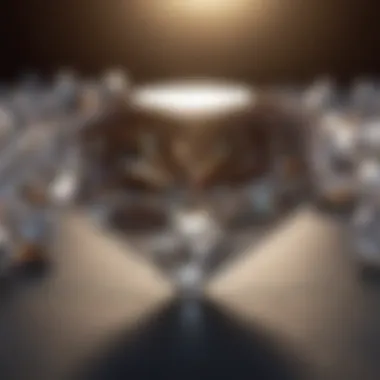
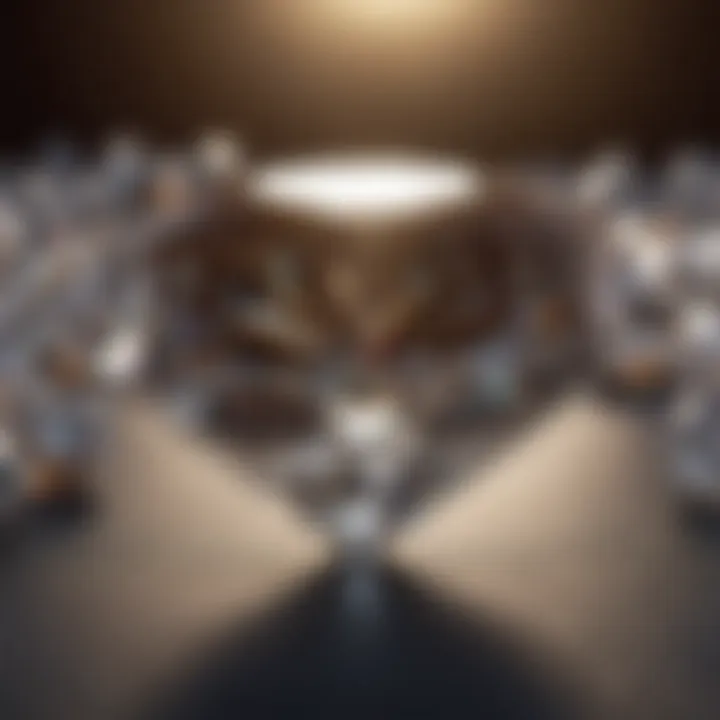
- Regular Cleaning:
Cleaning diamonds should be a routine task. Use a mild detergent and a soft brush to remove dirt and oils. This simple task can enhance the stone's brilliance. Additionally, do not use harsh chemicals or abrasive materials which may scratch the diamond or damage the setting. - Safe Storage:
Proper storage is crucial. Store diamonds in a soft cloth or a separate compartment away from other jewelry to prevent scratches. A jewelry box with padded compartments is ideal. - Avoiding Impact:
High-impact activities can cause chips or damage to a diamond. When engaging in activities like sports or manual labor, it is best to remove the diamond jewelry to avoid accidents. - Periodic Professional Check-ups:
Regular visits to a professional jeweler for inspections are advisable. Jewelers can assess the setting for wear and tear, ensuring the stone is secure. They can also perform a deep cleaning that is necessary for optimal appearance. - Be Cautious with Beauty Products:
Cosmetics and hair products can build up on diamonds. They dull the sparkle. It is advisable to apply such products before putting on jewelry, minimizing exposure and buildup.
Regular maintenance not only keeps your diamond looking stunning but also helps retain its resale value.
By implementing these practices, both collectors and enthusiasts can enjoy their brilliant shape diamonds for years to come. Remember, taking care of your diamond is as important as choosing the right one. Proper care ensures that these exquisite stones can be handed down through generations, retaining their beauty and value.
Trends in Gemstone Jewelry
In the context of gemstones, trends can dramatically shape consumer preferences and market dynamics. The rise in popularity of unique and personalized jewelry options signals a shift in how consumers view gemstones. This section delves into the role that brilliant shape diamonds play in contemporary jewelry trends, examining both the aesthetic and practical aspects of their designs. As the allure of brilliant diamonds continues to captivate, understanding current trends proves essential for enthusiasts and professionals alike.
One notable trend is the increasing demand for ethically sourced and sustainable diamonds. Consumers are more informed about the origins of their gemstones and actively seek out diamonds that are conflict-free. This heightened awareness has led many jewelers to incorporate brilliant shape diamonds that boast not only beauty but also ethical integrity.
Another key trend involves customization. As individuals express their unique styles through jewelry choices, the market sees an uptick in bespoke designs. Brilliant shape diamonds, known for their ability to reflect light spectacularly, serve as focal points in custom engagement rings and personalized jewelry. These diamonds excel in aligning with both traditional and modern designs, making them versatile choices for customization.
Additionally, mixing materials has become popular. Jewelers are pairing brilliant shape diamonds with other gemstones and various metals to create striking combinations. This mix enhances the visual appeal and adds depth to the designs, appealing to a broader audience.
Not to be overlooked, the influence of social media and celebrity endorsements has significantly impacted trends. Online platforms often showcase stunning pieces featuring brilliant shape diamonds, leading to increased visibility and desirability in the consumer market. Fashion influencers and celebrities frequently spotlight these diamonds, validating their status as a must-have in modern jewelry collections.
"The rise in the popularity of brilliant shape diamonds reflects a deeper appreciation for both craftsmanship and ethical sourcing in the jewelry industry."
As these trends evolve, they underline a critical point for gemstone enthusiasts, collectors, and jewelry designers alike: staying attuned to market shifts ensures informed purchasing and design choices. Awareness of ongoing trends assists in maximizing the investment value of brilliant shape diamonds, ultimately making a significant impact on consumer decisions.
Contemporary Designs Featuring Brilliant Diamonds
Contemporary designs that incorporate brilliant shape diamonds showcase innovation while honoring classic elegance. The various settings and styles that embrace these diamonds highlight their versatility and extraordinary light performance.
- Classic Solitaire: This timeless design remains a favorite. The brilliance of the diamond takes center stage, drawing all attention to its sparkle.
- Halo Settings: Brilliant shape diamonds surrounded by smaller stones enhance their dazzling effect. This design amplifies the visual impact, making the central diamond appear even larger.
- Three-Stone Rings: Often symbolizing the past, present, and future, these rings can feature a brilliant shape diamond flanked by two other stones, providing a meaningful yet stylish option.
- Modern Artistry: Some designers explore avant-garde styles, incorporating mixed metals and asymmetric layouts, creating pieces that challenge traditional designs while still showcasing the diamond's brilliance.
By examining these contemporary designs, we see how brilliant shape diamonds do not merely serve as decorative elements but as integral parts of the narrative conveyed through jewelry. As trends continue to unfold, the interplay between tradition and innovation remains crucial in refining the landscape of gemstone jewelry.
The Role of Brilliant Shape Diamonds in Culture
Brilliant shape diamonds hold a unique place in various cultures around the world. Their significance extends beyond mere aesthetic appeal; they often embody deep emotions, traditions, and status. The cultural roles of these diamonds offer insights not only into their beauty but also into the society that cherishes them.
One of the most prominent aspects of brilliant shape diamonds is their symbolism. They are frequently associated with love, commitment, and unity. This is especially evident in the context of engagement rings, where the diamond is seen as the ultimate representation of love and lifelong partnership. However, diamonds have also been symbols of power and wealth throughout history, signaling social standing and affluence in different eras.
Moreover, the rituals surrounding diamond allocation and gifting vary widely across cultures. In some societies, diamonds may be passed down through generations, serving as familial heirlooms. In others, they are given during specific life events, such as weddings, anniversaries, or significant birthdays. Such practices highlight the perceived value of brilliant shape diamonds, not just as commodities, but as vessels of meaningful memories and connections.
The significance of brilliant shape diamonds is not confined to Western cultures. In many Eastern cultures, they are regarded as talismans that provide protection and bring good fortune. In India, for instance, diamonds are thought to bring wisdom and promote a prosperous life. These beliefs illustrate the multifaceted role diamonds play across different contexts, reflecting both the aspirations and values of those who cherish them.
In summary, the role of brilliant shape diamonds transcends their physical attributes. They are potent symbols that resonate with the human experience, encapsulating notions of love, legacy, and prosperity. As we explore their cultural significance, we uncover layers of meanings that enrich our understanding of these exquisite gemstones.
Symbolism and Significance Across Cultures
Brilliant shape diamonds manifest diverse symbolic meanings across various cultures. Their roles may differ, but certain universal themes emerge.
- Love and Commitment: It is a common practice to associate diamonds, especially in brilliant cuts, with romantic commitments such as engagements and weddings. The diamond’s durability and clarity embody enduring love.
- Wealth and Power: Historically, diamonds have been markers of wealth. Royalty and nobility often adorned themselves with diamonds, showcasing their status.
- Socio-Cultural Beliefs: Different cultures ascribe various meanings to diamonds.
- Rituals and Traditions: Diamonds can play a crucial role in cultural rites. They might be part of rituals celebrating milestones or family legacies passed through generations.
- In Western societies, they are often seen as symbols of luxury and success.
- In Eastern cultures, they may represent spiritual protection and good fortune.
"A diamond is forever, but its meanings can shift and deepen with each new generation and culture."
Through examining these symbolic and practical elements, we appreciate how brilliant shape diamonds are woven into the fabric of cultural identity and personal narratives. They are not just precious stones; they embody human experiences and societal values, underscoring their significance in various cultural contexts.
Future Outlook
The future of brilliant shape diamonds is not only fascinating but also crucial to understanding their place in the market and culture. As consumer preferences evolve, the demand for unique and ethically sourced diamonds is increasing. Buyers are prioritizing both aesthetics and sustainable practices. This shift reinforces the necessity for innovative approaches in diamond engagement, especially in terms of sourcing, cutting, and marketing.
Innovations in Diamond Engagement
Technological advancements are shaping how diamonds are cut, showcased, and sold. With tools such as computer-aided design (CAD) and laser cutting, precision in diamond craftsmanship has reached new heights. This not only improves the quality of the cuts but also allows for more intricate designs, appealing to the modern buyer's taste.
"The diamond industry is on the cusp of a revolutionary technological era."
In addition to cutting innovations, the way diamonds are marketed is transforming. Social media platforms like Facebook and Reddit are becoming key channels for engagement. Brands are utilizing these platforms to showcase unique designs, ethical sourcing stories, and to directly interact with their customers.
The rise of lab-created diamonds is another significant trend. These diamonds, which can replicate the physical and chemical properties of natural diamonds, offer an accessible alternative at a lower price point. This can attract a wider range of consumers who value both beauty and ethical considerations.
Key factors influencing the future landscape of diamond engagement include:
- Customization: Increasing demand for personalized jewelry is prompting designers to offer bespoke services. Customers are now looking for a narrative and connection in their purchases.
- Sustainability: More buyers are seeking ethically sourced diamonds. Brands that commit to environmentally friendly practices will resonate with conscious consumers.
- Digital experience: Virtual try-ons and augmented reality are enhancing customer experience, allowing potential buyers to visualize how a diamond would look without needing to be physically present in a store.
Considering these elements, the future outlook for brilliant shape diamonds indicates a more inclusive and innovative market. It appears essential for businesses to adapt continuously and align their offerings with what consumers desire. As a result, the life cycle of diamonds, from extraction to sale, will likely witness transformative changes, enhancing their long-term viability in the marketplace.
Ending
The conclusion serves as a crucial segment of the discourse surrounding brilliant shape diamonds. It encapsulates the key insights and lessons drawn from the comprehensive analysis presented in this article. In a field as intricate as gemstones, where knowledge is paramount, summarizing the core themes enables readers to retain the most essential information.
Understanding the multifaceted nature of brilliant shape diamonds contributes to a deeper appreciation for their artistry and craftsmanship. This appreciation is not merely aesthetic; it encompasses the history, technology, and market dynamics that define these stones. The discussion on cutting techniques highlights the precision and advanced methods that have evolved over time, enhancing both the beauty and value of these diamonds.
Additionally, the exploration of characteristics such as brilliance, clarity, and color allows enthusiasts and professionals alike to make informed decisions, whether they are selecting stones for personal investment or designing jewelry pieces. Such guidance is invaluable in a market that can often seem overwhelming.
Key Takeaways about Brilliant Shape Diamonds
- Expertise and Knowledge: Acquiring specifics about each variant of brilliant diamonds enriches the purchasing process. Knowledge about grading and certifications empowers buyers in making confident choices.
- Cultural Significance: Recognizing the symbolic importance of diamonds across various cultures enhances their value beyond the monetary aspect. This attribute can influence personal connections and choices regarding these stones.
- Future Landscape: Staying informed about innovations in diamond engagement and design positions stakeholders advantageously within the competitive landscape of the jewelry market.
"A diamond is forever" reflects not just a marketing slogan but a profound truth about the enduring allure and significance of these gemstones in human history.
Overall, the intricacies surrounding brilliant shape diamonds reveal much about human creativity, cultural dynamics, and the treasures that we hold. Collectors, jewelry designers, and gemstone enthusiasts can thus navigate this elaborate domain with a more nuanced understanding, ensuring their engagement with these gems is both meaningful and rewarding.







